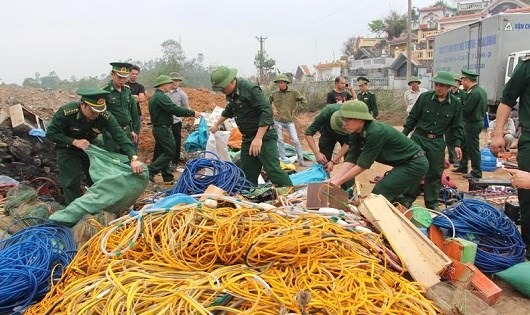Abandoned Shrimp Pond, Farmers Sell Their Land To Live In Another Place
Stocking shrimp seeds.
Many farmers in remote districts made their lives better by raising this type of seafood. Those who raised less also had an income of more than 100 million VND per year, other households could also make more than one hundred million VND easily.
But now, when coming to Phu Thanh B Commune – one of a largest giant freshwater shrimp farming areas in the district, it will be difficult to find out any shrimp farming household. The whole district currently has only 9.1 ha with 4 farming households. The main crop of the year is coming, but in the current situation, it can be predicted that Tam Nong people will not stock giant freshwater shrimps in another year.
The area of giant freshwater shrimp farming begins to show signs of decline since 2012, however, the shrimp farming movement will still be maintained in the following years thanks to the support of the local authorities combined with the determination of the farmers. However, in the past few years, the number of farmers in the whole district can only be counted on the fingers. These are the farmers who are still very “devoted” to the shrimp farming together with the hope that “the heyday” will return.
There are many causes leading to the above situation, but it can be mentioned three main causes, as follows:
Shrimp seed: with the special characteristics of farming giant freshwater shrimp in the flood season, farmers often take advantage of the cultivated-land areas to farm shrimp when the flood comes. Therefore, the farming area is usually very large, the average farming area of each household is from 2 to 5 ha; and to households stocking a lot of shrimp, the farming area can be up to more than ten hectares.
Stocking shrimp has a seasonal characteristic (start to stock shrimp seeds while waiting for the floods coming) with a large area, the demand for shrimp seeds for the whole region is so great. While there are not any available hatcheries in the district, most of shrimp seeds are provided by hatcheries from localities inside and outside of the province. Because the seed supply is not enough to meet the farmers’ demand, which have led to the situation that the hatcheries are only chasing the market’s demand without focusing on strict management of shrimp seed origin, and its quality is increasingly declining.
The converted model of shrimp farming to rice cultivation
On the farmers’ side, their belief of quality is completely given to the hatcheries. To them, having a batch of shrimp seed to stock on the right season is a lucky thing. Thus, if any famers are lucky, their batches of shrimp seed have a high survival rate, shrimps grow quickly and bring high profits. On the contrary, if they buy bad shrimp seeds, shrimps grow slowly, the loss rate is high, make non-profits, even at a loss.
That is not to mention a series of shrimp seed originating from China, Thailand, Taiwan … with higher prices than domestic seeds, but their quality cannot be controlled.
Environment: Any aquatic species also need a good water environment to be able to grow and develop well, especially giant freshwater shrimp. In the first years when the shrimp farming movement in the flood season just started to develop. Since the flood came back every year and flooded the fields, people had to use nets to keep shrimps. In such conditions, giant freshwater shrimp grew very quickly, 6 to 7-month raising shrimp can reach 50-70g/unit, the larger shrimps could reach up to 120-150gr/unit, and gave the yield of 2-3 tons/ha.
It is so difficult to raise giant freshwater shrimps well, but selling them into the market is even more difficult. The market of giant freshwater shrimp consumption in Tam Nong is becoming narrower and more difficult than ever, which has also made famers no longer interested in farming shrimp.
Shrimp farming has been more than a decade since its inception, but only for a while, there were some exporting companies coming to purchase products of farmers in limited quantities, the rest still had to rely on the trader system for domestic consumption. The Tam Nong giant freshwater shrimps were only sold in the traditional market of region, a few products were consumed at the restaurant, bistros, and so on. The export was still limited.
Therefore, if it takes 6-8 months for farmers to raise a pond of a few tons of shrimp, it will take more than a month to sell all of them! The quantity of consumption is few, but current traders still force to reduce the price and do not purchase because it is currently competing with giant freshwater shrimps of Bac Lieu and Soc Trang provinces which had a good quality and bigger size than the size of shrimp of Tam Nong. Mr. Duong Van Dien – a household head with more than ten years of experience said when he was asked whether to continue farming the giant freshwater shrimp or not, “I am still very eager to raise the giant freshwater shrimp if the government has any methods to attract enterprise to purchase products of farmers easily. How dare we can raise shrimps if no one buys them.”
According to Lam Trong Nghia (NNVN)





